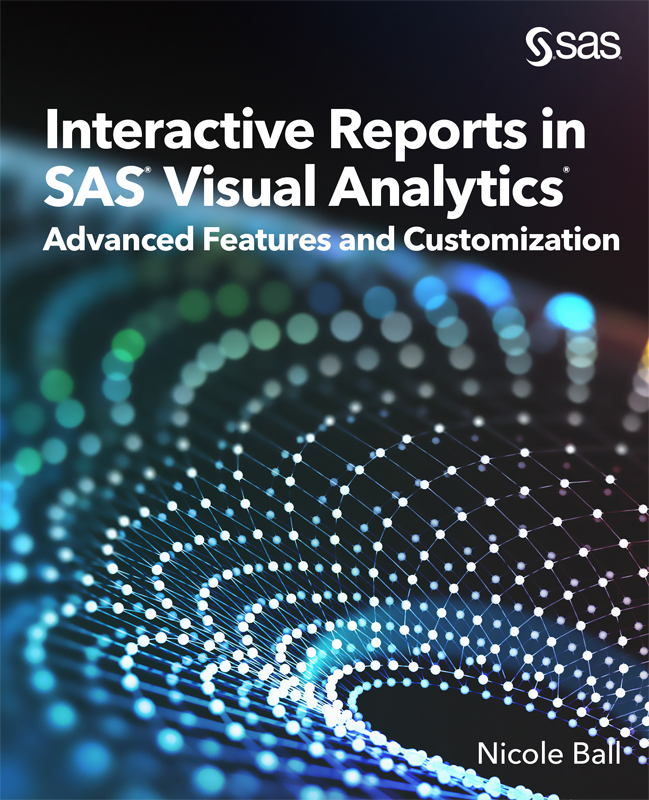Interactive Reports in SAS Visual Analytics
Advanced Features and Customization
Nicole Ball
 sas.com/books
sas.com/books
The correct bibliographic citation for this manual is as follows: Ball, Nicole. 2021. Interactive Reports in SAS Visual Analytics: Advanced Features and Customization . Cary, NC: SAS Institute Inc.
Interactive Reports in SAS Visual Analytics: Advanced Features and Customization
Copyright 2021, SAS Institute Inc., Cary, NC, USA
ISBN 978-1-954846-70-8 (Hardcover)
ISBN 978-1-953330-53-6 (Paperback)
ISBN 978-1-953330-54-3 (Web PDF)
ISBN 978-1-953330-55-0 (EPUB)
ISBN 978-1-953330-56-7 (Kindle)
All Rights Reserved. Produced in the United States of America.
For a hard copy book: No part of this publication may be reproduced, stored in a retrieval system, or transmitted, in any form or by any means, electronic, mechanical, photocopying, or otherwise, without the prior written permission of the publisher, SAS Institute Inc.
For a web download or e-book: Your use of this publication shall be governed by the terms established by the vendor at the time you acquire this publication.
The scanning, uploading, and distribution of this book via the Internet or any other means without the permission of the publisher is illegal and punishable by law. Please purchase only authorized electronic editions and do not participate in or encourage electronic piracy of copyrighted materials. Your support of others rights is appreciated.
U.S. Government License Rights; Restricted Rights: The Software and its documentation is commercial computer software developed at private expense and is provided with RESTRICTED RIGHTS to the United States Government. Use, duplication, or disclosure of the Software by the United States Government is subject to the license terms of this Agreement pursuant to, as applicable, FAR 12.212, DFAR 227.7202-1(a), DFAR 227.7202-3(a), and DFAR 227.7202-4, and, to the extent required under U.S. federal law, the minimum restricted rights as set out in FAR 52.227-19 (DEC 2007). If FAR 52.227-19 is applicable, this provision serves as notice under clause (c) thereof and no other notice is required to be affixed to the Software or documentation. The Governments rights in Software and documentation shall be only those set forth in this Agreement.
SAS Institute Inc., SAS Campus Drive, Cary, NC 27513-2414
August 2021
SAS and all other SAS Institute Inc. product or service names are registered trademarks or trademarks of SAS Institute Inc. in the USA and other countries. indicates USA registration.
Other brand and product names are trademarks of their respective companies.
SAS software may be provided with certain third-party software, including but not limited to open-source software, which is licensed under its applicable third-party software license agreement. For license information about third-party software distributed with SAS software, refer to http://support.sas.com/thirdpartylicenses .
Contents
About This Book
What Does This Book Cover?
This book contains a variety of examples that enable you to create interactive reports in SAS Visual Analytics using advanced features and customization. You can create interactive links to external websites, use parameters to give the viewer more control over the report, create and add custom graphs and third-party visualizations, execute SAS code using SAS Viya jobs, and even embed report content in your own web pages and apps.
This book does not discuss basic functionality in SAS Visual Analytics, like how to create reports, use report objects, apply filters, or add basic actions or links. It is intended for users that are already familiar with both basic and advanced functionalities in SAS Visual Analytics and want to create more advanced interactive reports that enable viewers to exert more control over their report-viewing experience.
Is This Book for You?
This book is intended for users who are familiar with both basic and advanced features in SAS Visual Analytics. If you do not have any experience with SAS Visual Analytics, see An Introduction to SAS Visual Analytics: How to Explore Numbers, Design Reports, and Gain Insight into Your Data by Tricia Aanderud, Rob Collum, and Ryan Kumpfmiller. You can also take the SAS Visual Analytics 1 for SAS Viya: Basics course and the SAS Visual Analytics 2 for SAS Viya: Advanced course.
What Are the Prerequisites for This Book?
Before reading this book and working with the examples, you should know how to do the following:
- Access SAS Visual Analytics
- Build a basic report
- Create calculated items and aggregated measures and understand the difference between the two
- Use objects in SAS Visual Analytics to build reports
- Modify roles and options for report objects
- Create basic filters, actions, links, display rules, and ranks
How to Use This Book
This book can be used as a resource for you to incorporate more advanced functionality and interactivity into your SAS Visual Analytics reports. You dont have to read the book in order! There are many ways you can approach learning and applying the information in this book:
- Just-in-time learning : Use the chapters and examples as you need them. For example, if you need to learn different ways that you can create advanced links, see : Linking to External Websites .
- Learn more about using the Data pane : Focus on creating more advanced data items using the Data pane and apply them to your reports. For this approach, see : Working with Date Parameters .
- Learn more about customizations : Focus on creating your own custom graphs and experiences. For this approach, see .
- Learn about using date data items : Focus on creating and using date data items for your reports. For this approach, see the following examples:
- - Example: Creating a Calculated Item and a Basic Filter
- - Example: Viewing Data for the Next N Years
- All examples in : Working with Date Parameters
- Learn about Geo maps : Learn about creating different types of geographic data items (using predefined roles, using latitude and longitude, and using custom polygonal shapes). For this approach, see the following examples:
- - Example: Linking to a File (coordinate geo map using latitude and longitude)
- - Example: Viewing a Map Location (coordinate geo map using latitude and longitude)
- - Example: Linking to a Parameterized Report (region geo map using predefined geographic roles)
- - Example: Grouping Values Based on a Threshold (region geo map using predefined geographic roles)
- - Example: Viewing Data for the Next N Years (coordinate geo map using latitude and longitude)
- - Example: Selecting a Region (region geo map using custom predefined geographic roles and custom polygonal shapes)
- - Example: Highlighting a Selected Month (coordinate geo map using latitude and longitude)
- - Example: Viewing 10 Years after a Selected Year (coordinate geo map using latitude and longitude)
- - Example: Building a Custom Map (coordinate geo map using latitude and longitude)
- - Example: Building a Custom Map with Polygon Layers (region geo map overlaid with coordinate geo map using custom polygonal shapes and latitude and longitude)













 sas.com/books
sas.com/books